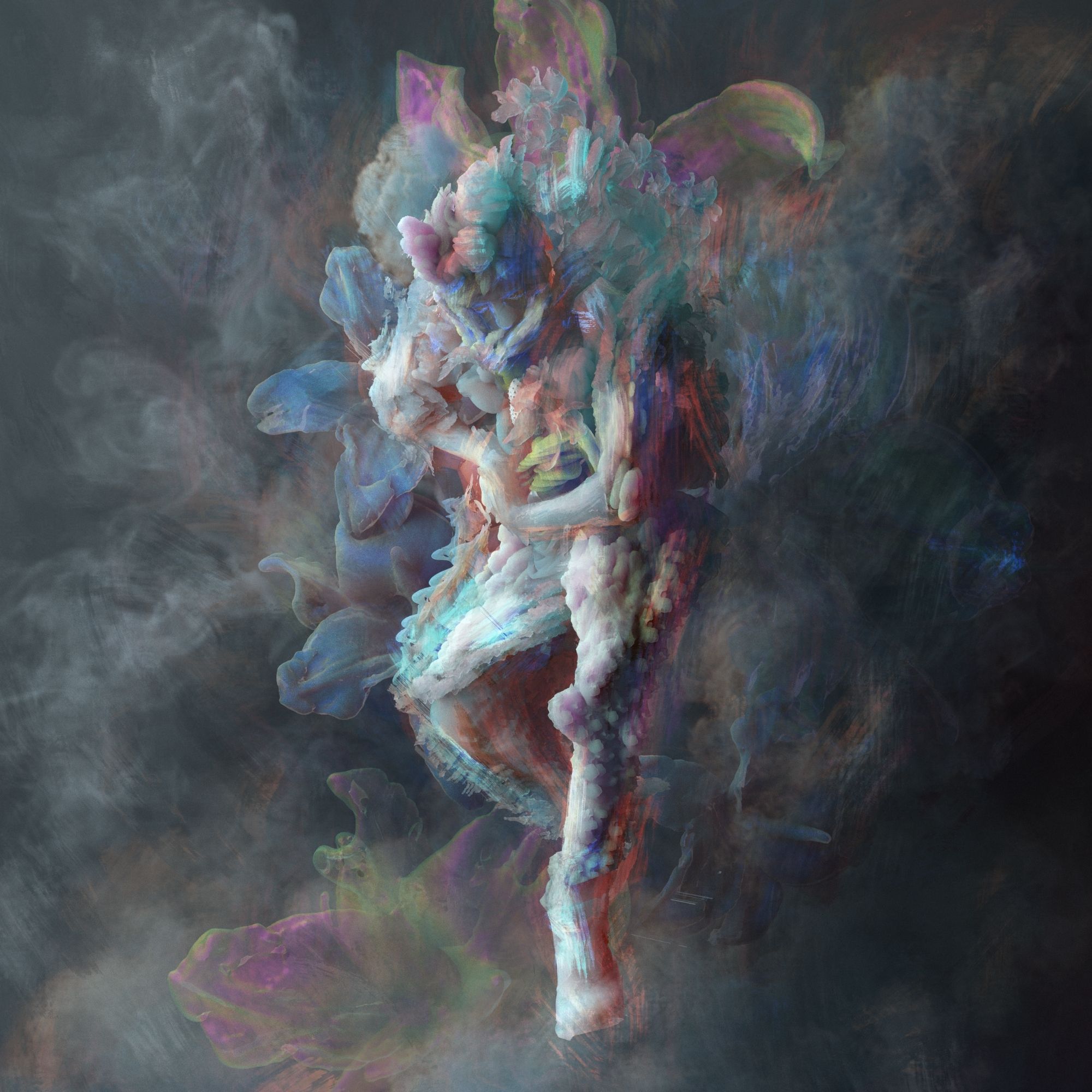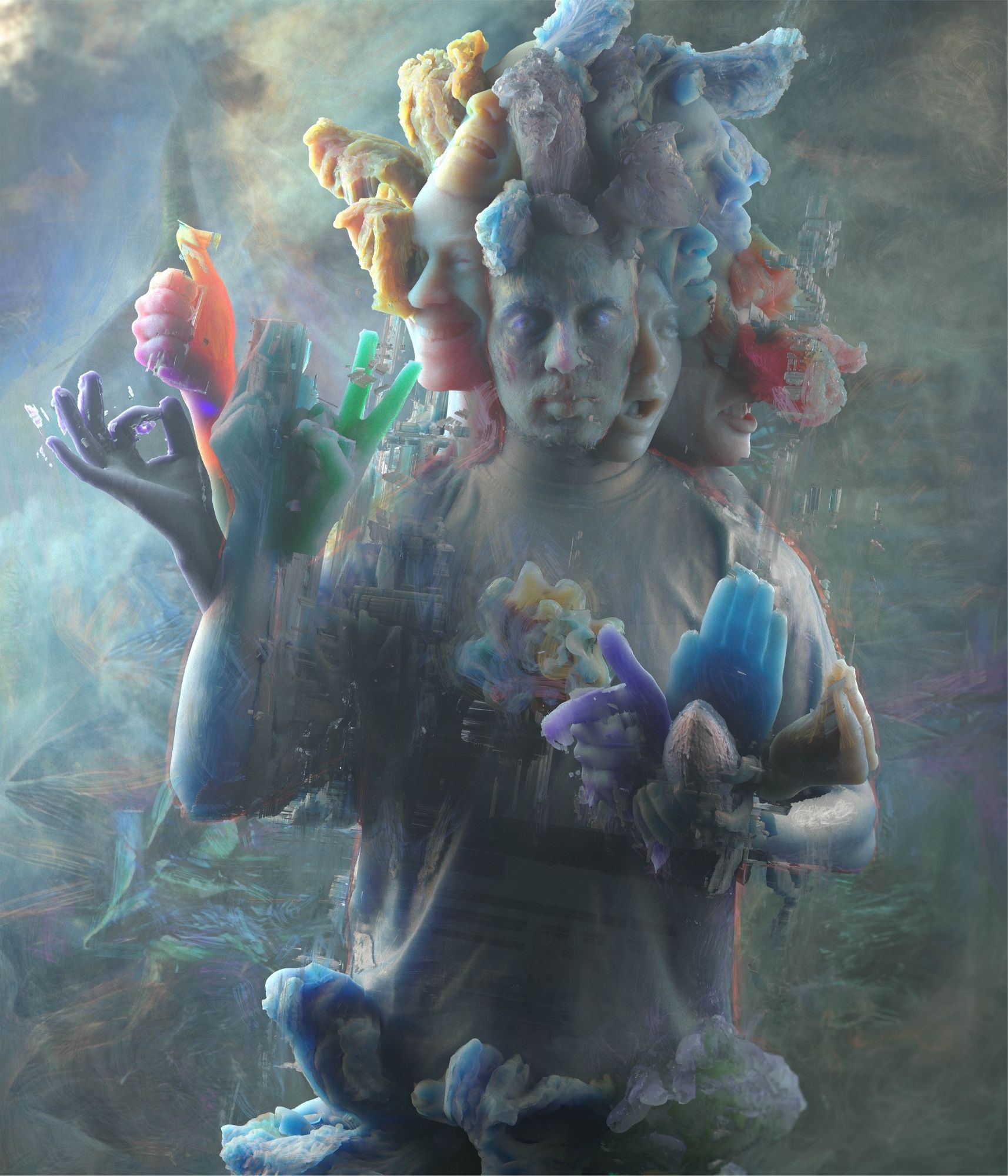Nate Talbot

Nate Talbot Biopic, 2021. Image Credit: Justin Elliott
Artist name: N8
Self-identify/cultural heritage/ethnic background: Ojibwe, black, settler.
School credentials: B.A. (H) Philosophy University of Windsor Pre-apprenticeship Electrical Techniques St. Clair College MFA University of Windsor (in progress)
Type of Art/Artwork style: I would describe my work as surrealistic, dark, and ethereal. I work in virtual reality to sculpt with 3D scans of fruit, fungi, plants, and myself. I am interested in exploring the question of exactly what changes when natural forms move through technology and digital spaces.
Social Media handles:
@nate__talbot/
https://www.natetalbot.ca/
Artist Biography Nate Talbot:
I see myself as a medium between the immaterial digital world and the spirit world. I aim to deconstruct the tension between virtual and material planes, between my mixed Ojibwe and settler identities, and between technology and spirituality. I invoke digital beings through sculpting in virtual reality. With my work I invite my viewer to think about the liminal space between the simulation and the subconscious; exploring both the transcendent heights, as well as the ego-dissolving depths of our own minds entangled with technology.
I work in virtual reality to sculpt with 3D scans of fruit, fungi, and crystals, and humans. I also forage for flowers, local mushrooms, and living objects in the process of decay to 3D scan these objects. To me the process of 3D scanning living things immortalizes these beings. I am interested in exploring the question of exactly what changes when natural forms move through technology and digital spaces and emerge back into the physical world. To me this process serves as an analog to how the use of technology modifies our own being. I see the act of creating sculpts in VR as a type of shamanism, meditation, hallucination, and deep introspection.
I am fascinated by the idea of the hologram-- that the whole can be contained in the part. As an extension of my 3D renders, I bring my renders to life using holographic screens, giving the viewer the illusion of being surrounded by digital spectres. At the core I wish for my work to be seen as ambiguous and self-reflexive-- suspended halfway between delusion and ascension. At its core I want to deconstruct the categorical divide between technologically-produced simulation, and real biological being.
I am currently in my first year of my MFA at UWindsor, and work as a graduate researcher for INCUBATOR BioArt Lab.

Nate Talbot, Lucid, 2021. Artwork medium: Oculus Medium, 3D scans, machine learning, C4D, Houdini, Octane Oculus Medium, 3D scans, machine learning, C4D, Houdini, Octane
Questions and Answers (Q&A) for Artist Nate Talbot:
Q1) Which type/form of artwork style do you use in your artwork and why?
I think that my art is between so many genres that it’s difficult to pinpoint exactly where my aesthetic comes from. Although my art is done in CG programs, I usually paint over my works in photoshop or on my iPad to give my works a painterly look. My origins as an artist come from traditional oil painting– my early works are very Francis Bacon/Zdzisław Beksiński-esque. In my current work I use elements of sci-fi art (very influenced by retro sci-fi artists like Moebius) through my references to biomorphic forms + mutation. I reference post-impressionism with the way my figures almost emerge from the ether and are part of it. I would also describe my work as having an affinity to the symbolists like Gustav Klimt or Odilon Redon. A lot of my work contains esoteric references, and use objects as symbols which have a private meaning (ex. The use of a 3D scan of star anise to convey the duality of medicine and poison).
Q2) Who are your favourite artists and why?
My favourite artists are David Altmejd, and Miles Johnston. David Altmejd is a Canadian mixed-media sculptor who combines faux fruit, crystals, plexiglass, silicon, taxidermied animals, clay and so on to create representations of humans in the midst of a metamorphosis. What I like most about Altmejd’s work is the way he carefully positions his work between death and transformation, as well as how he explores animism– the idea that all things contain life. Miles Johnston is an illustrator based in Sweden. He creates realistic portraits of people with a surrealistic twist– but this twist almost always reflects something internal or introspective in nature. He explores the sublime (the beautiful and the terrifying) in a way that I seek to accomplish in my own art.
Q3) Despite challenges and barriers what motivates you to continue to persevere in the Art World? and why?
There are so many challenges to finding lasting success in the art world– making sales, making connections, and also just finding the inspiration to make art. What I’ve found to be the biggest challenge as an artist is to face one’s inner critic. I often think about a quote (can’t remember the source) that said it’s actually a good thing when one’s taste exceeds one’s talent– because there’s always room for improvement. I would suggest embracing the imperfections in one’s art– if they weren’t there the work wouldn’t have as much soul. What continues to motivate me to make art is simply the need to communicate an emotion, idea, or vision that can only be said through art.
Q4) How do you view the intersections of Art and Science?
Art and science are fundamentally entangled. There are certain stereotypes that art is foundationally creative, and science is at its core a system of logic, but the truth is that each field contains aspects from the other. For example, in the type of art that I do I have to use a VFX program called Houdini to create my smoke/pyro simulations. This simulation is artistically directed by me, but to create it in the first place, Houdini uses real-world physics based calculations such as velocity, density, turbulence, and so on to create this simulation. What also uses real-world physics is the program that I use for the majority of my art, Cinema4D. To make my materials (what I texture my sculptures with like glass, marble, wax, metal, and so on) I have to know the optical qualities of the materials I aim to replicate. A lot of it is trial and error, but if you were to ask me to recreate a material in real life and translate it to my CG program, chances are it would have many of the same physical properties as the real life counterpart– you have to know what optical terms like index of refraction, diffusion, opacity, sub-surface scattering medium are in order to do this.

Nate Talbot, Rapture, 2021. Artwork medium: Oculus Medium, 3D scans, C4D, Houdini, Octane.v

Nate Talbot, Anima Mundi, 2021. Artwork medium: Oculus Medium, 3D scans, machine learning, C4D, Houdini, Octane.
